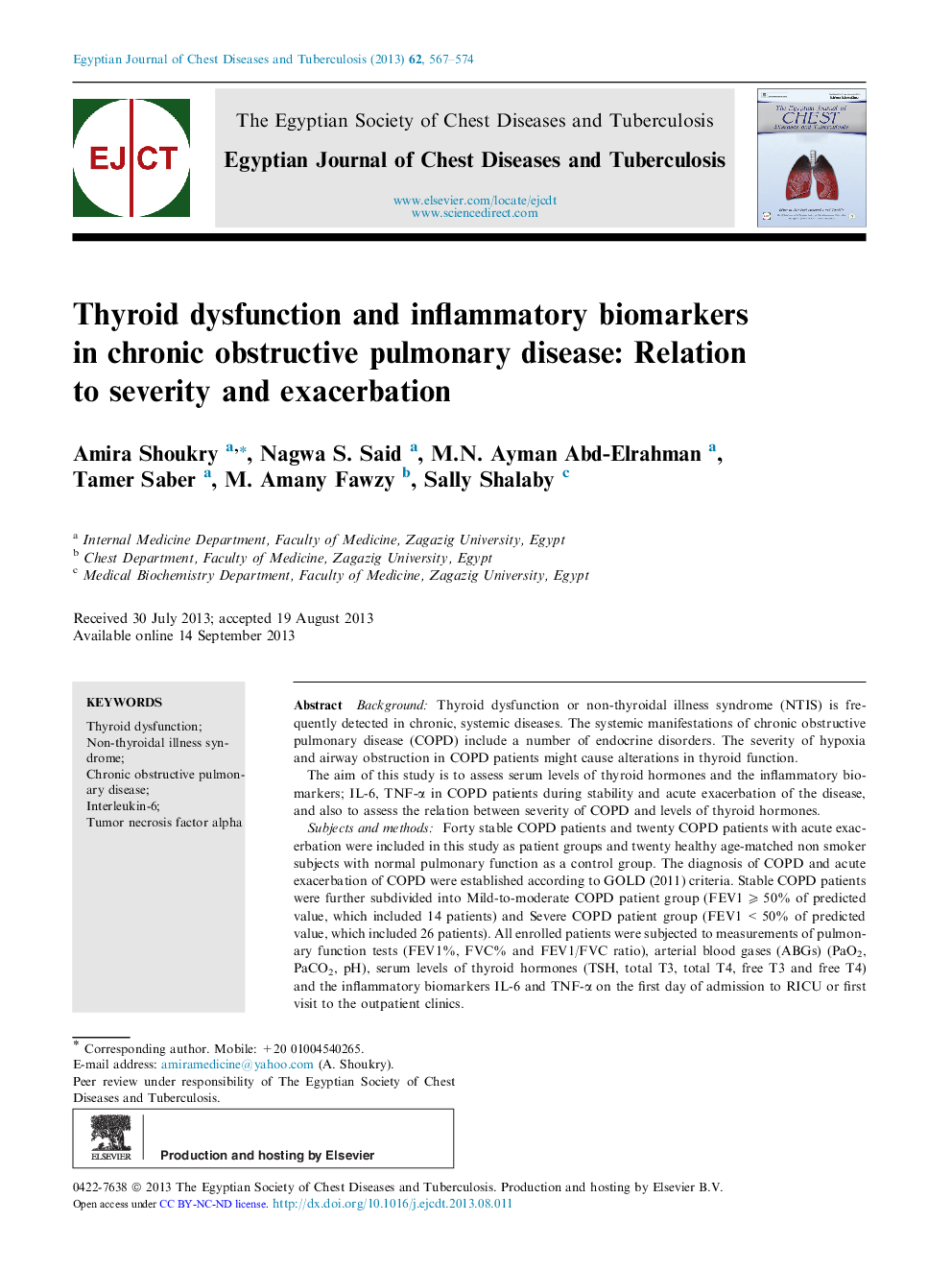| Article ID | Journal | Published Year | Pages | File Type |
|---|---|---|---|---|
| 3400415 | Egyptian Journal of Chest Diseases and Tuberculosis | 2013 | 8 Pages |
BackgroundThyroid dysfunction or non-thyroidal illness syndrome (NTIS) is frequently detected in chronic, systemic diseases. The systemic manifestations of chronic obstructive pulmonary disease (COPD) include a number of endocrine disorders. The severity of hypoxia and airway obstruction in COPD patients might cause alterations in thyroid function.The aim of this study is to assess serum levels of thyroid hormones and the inflammatory biomarkers; IL-6, TNF-α in COPD patients during stability and acute exacerbation of the disease, and also to assess the relation between severity of COPD and levels of thyroid hormones.Subjects and methodsForty stable COPD patients and twenty COPD patients with acute exacerbation were included in this study as patient groups and twenty healthy age-matched non smoker subjects with normal pulmonary function as a control group. The diagnosis of COPD and acute exacerbation of COPD were established according to GOLD (2011) criteria. Stable COPD patients were further subdivided into Mild-to-moderate COPD patient group (FEV1 ⩾ 50% of predicted value, which included 14 patients) and Severe COPD patient group (FEV1 < 50% of predicted value, which included 26 patients). All enrolled patients were subjected to measurements of pulmonary function tests (FEV1%, FVC% and FEV1/FVC ratio), arterial blood gases (ABGs) (PaO2, PaCO2, pH), serum levels of thyroid hormones (TSH, total T3, total T4, free T3 and free T4) and the inflammatory biomarkers IL-6 and TNF-α on the first day of admission to RICU or first visit to the outpatient clinics.ResultsThere was a significant decrease in serum total T3 and free T3 levels in stable COPD patients when compared to control subjects. Also, there was a significant decrease in serum total T3, free T3, TSH levels and TT3/TT4 ratio in the COPD exacerbation patient group when compared to control subjects and when compared to stable COPD patients. There were no statistically significant differences in serum levels of total T4, free T4 between the studied groups. Regarding disease severity, serum total T3, free T3 levels and TT3/TT4 ratio were significantly decreased in severe COPD patients when compared to mild-to-moderate COPD patients. There were significant positive correlations between PaO2 and both serum total T3 and TT3/TT4 ratio in the stable COPD group. Serum IL-6 and TNF-α levels were significantly increased in both stable and exacerbation phase COPD patient groups when compared to control subjects.ConclusionCOPD is a systemic disease that may produce significant alterations in serum levels of thyroid hormones, especially in severe COPD patients and during exacerbation phases of COPD where NTIS is more evident. There was a significant decrease in serum total T3 and free T3 levels in stable COPD patients and this decrease was more significantly evident with a superadded significant decrease in serum TSH levels during the exacerbation phase of COPD. The hormonal alterations are especially related to severity of the disease and hypoxemia. Serum IL-6 and TNF-α levels were increased even in stable COPD and this rise is magnified with increased disease severity and during exacerbation phases of COPD.
